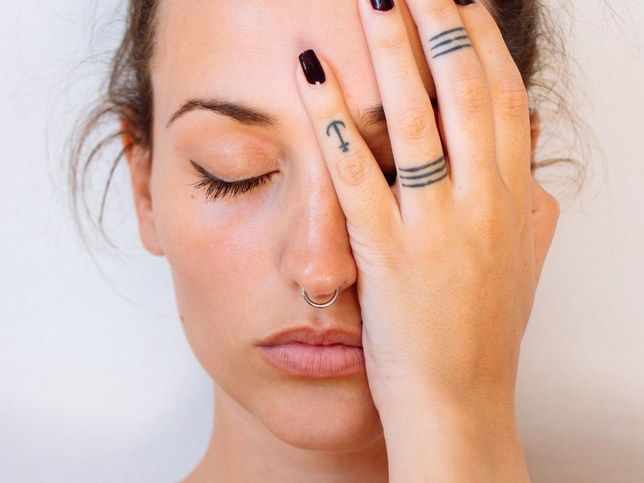Adult Acne, Still? How to Deal When Your Face Thinks You’re 13

There are very few things that feel as unfair, at least in the beauty realm, as waking up with pimples when you’re a grown-ass woman. The one thing that softens the blow: Acne is no longer something to be ashamed of and to mask in heaps of concealer (see celebrity Instagram selfies of spot treatments and the viral world of YouTube phenomenon Dr. Pimple Popper). Still, having a face full of zits in your thirties is a drag, and with derms telling us that female adult acne is on the rise, we hunted down the latest fixes to cure and prevent it, without turning into a flaky mess.
First, Know Why You’re Breaking Out
Hormones—they continue to act up. You know your hormones were behind the acne of your adolescence. During puberty, “your hormones are suddenly acting on your oil glands,” explains R. Sonia Batra, M.D., a dermatologist in Santa Monica, California. “Skin tends to be very oily; pustules and inflamed spots crop up at the surface of the skin.” Most breakouts in adulthood are still hormone-related; it’s just that now they tend to fluctuate around your cycle or be triggered by other influences (see below). And adult acne looks different: “It’s more clogs, blackheads, and whiteheads all over, as well as inflamed cysts and pimples along the jawline and upper neck,” says New York City dermatologist Neal Schultz, M.D.
Stress could trigger breakouts too.Again, hormones play a role: “When you experience stress, the adrenal gland secretes hormones like cortisol, and with that androgens,” Dr. Schultz says. In some women, that’s enough to make oil glands secrete more oil and cause acne.
And so can lifestyle factors like diet and pollution.Your grandmother’s warning that greasy foods will give you zits is probably untrue. But “there is some data suggesting that hormones in meat and dairy may affect your skin,” Dr. Batra says. “Check labels to make sure your food is hormone-free or organic.” Also keep refined sugar and starchy foods in check, as insulin could impact your hormones. And while a link between pollution and acne is still being researched, Dr. Schultz has personally noticed a spike of acne cases in his practice when women move to the city from rural areas. A precautionary practice: Wash your face after you’ve been outside all day.
Now Here’s Your Game Plan: Start at Home
When treating breakouts, skip the harsh products you used as a teenager, says Dr. Batra (“You’ll just get dried out and irritated”) and look for gentler treatments that also have glow-boosting benefits. Retinoids and alpha hydroxy acid topicals should be used all over and every day—even when you’re not breaking out. “They work preventively to decrease oil production and stop pores from clogging so that acne does not develop,” Dr. Batra says. Also, moisturize. You’ll need to balance out any drying effects. Here’s what to try.
For continual breakouts:Adapalene (found in Differin and in the new ProactivMD line) is ideal for adult acne, since it was “synthesized to be less irritating,” Dr. Batra says.
For zits—with a side of discoloration and lines:Retinols (found in Honest Beauty Younger + Clearer Night Serum) and AHAs (like glycolic acid—try Beauty RX by Dr. Schultz Essential 8% Exfoliating Serum) can help keep pores clear by constantly exfoliating skin and turning over dead skin cells (these products also help to soften lines and brown spots).
For inflamed flare-ups:Salicylic acid kills bacteria, dissolves clogs by exfoliating skin, and brings down inflammation. If leave-on options sting, switch to a cleanser so it’s in contact with your skin for only a short time; we like Clean & Clear Acne Triple Clear Cleanser.
For speed-healing deep cysts:Light therapy has no dehydrating side effects and can be used daily. Foreo’s Espada tool uses targeted blue light to eliminate acne-causing bacteria, and Neutrogena’s Light Therapy Acne mask combines skin-soothing red light with blue light and treats your entire face.
For the big ones:Benzoyl peroxide. But it can be irritating, so it’s an exception to the all-over-the-face approach. Look for smaller percentages (like the 5 percent in Clinique Acne Solutions Emergency Gel-Lotion) and reserve it for tough flares.
Still Breaking Out? Head to the Derm
Most doctors will take a multipronged treatment approach so that “you have tools in place to keep you from rebounding when you taper off one,” says Dr. Batra, who often starts her patients with topical treatments unless they have cystic acne, which is more effectively treated with an oral med. The deal on both:
The topical treatments:The anti-inflammatory gel Aczone is lauded by derms for its ability to calm blemishes without being too harsh. The latest version, a 7.5-percent strength, needs to be applied only once daily—ideal if you’re always forgetting your zit cream. Topical antibiotics (such as clindamycin) work similarly and can be used as spot treatments to nix bacteria.
The oral medications to consider:Think about switching up your birth control to regulate your hormones, or talk to your doctor about spironolactone, a diuretic blood pressure treatment that’s prescribed off-label more and more for its skin-clearing side effect in women. “It doesn’t alter your hormones, but it blocks the effects of androgen on your skin,” Dr. Batra explains. Clear skin: not so far off after all.
Related Stories:
-I Did Microneedling Before My Wedding and It Gave Me the Best Skin of My Life
-11 Breakout Treatments That Actually Work
-The Totally and Completely Unfair Reason You’re Still Breaking Out in Your 20s and 30s

